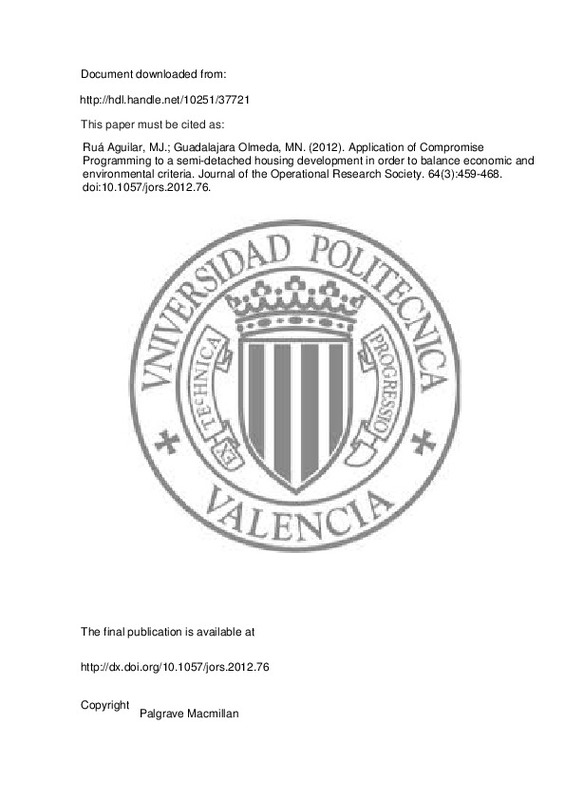Andaloro, A. P. F., Salomone, R., Ioppolo, G., & Andaloro, L. (2010). Energy certification of buildings: A comparative analysis of progress towards implementation in European countries. Energy Policy, 38(10), 5840-5866. doi:10.1016/j.enpol.2010.05.039
André, F. J., Cardenete, M. A., & Romero, C. (2008). Using compromise programming for macroeconomic policy making in a general equilibrium framework: theory and application to the Spanish economy. Journal of the Operational Research Society, 59(7), 875-883. doi:10.1057/palgrave.jors.2602415
Baja, S., Chapman, D. M., & Dragovich, D. (2006). Spatial based compromise programming for multiple criteria decision making in land use planning. Environmental Modeling & Assessment, 12(3), 171-184. doi:10.1007/s10666-006-9059-1
[+]
Andaloro, A. P. F., Salomone, R., Ioppolo, G., & Andaloro, L. (2010). Energy certification of buildings: A comparative analysis of progress towards implementation in European countries. Energy Policy, 38(10), 5840-5866. doi:10.1016/j.enpol.2010.05.039
André, F. J., Cardenete, M. A., & Romero, C. (2008). Using compromise programming for macroeconomic policy making in a general equilibrium framework: theory and application to the Spanish economy. Journal of the Operational Research Society, 59(7), 875-883. doi:10.1057/palgrave.jors.2602415
Baja, S., Chapman, D. M., & Dragovich, D. (2006). Spatial based compromise programming for multiple criteria decision making in land use planning. Environmental Modeling & Assessment, 12(3), 171-184. doi:10.1007/s10666-006-9059-1
Ballestero, E., & Romero, C. (1991). A theorem connecting utility function optimization and compromise programming. Operations Research Letters, 10(7), 421-427. doi:10.1016/0167-6377(91)90045-q
Ballestero, E., & Romero, C. (1993). Weighting in compromise programming: A theorem on shadow prices. Operations Research Letters, 13(5), 325-329. doi:10.1016/0167-6377(93)90055-l
Davies, H., & Wyatt, D. (2004). Appropriate use of the ISO 15686-1 factor method for durability and service life prediction. Building Research & Information, 32(6), 552-553. doi:10.1080/0961321042000291938
Diakaki, C., Grigoroudis, E., Kabelis, N., Kolokotsa, D., Kalaitzakis, K., & Stavrakakis, G. (2010). A multi-objective decision model for the improvement of energy efficiency in buildings. Energy, 35(12), 5483-5496. doi:10.1016/j.energy.2010.05.012
Dı́az-Balteiro, L., & Romero, C. (2003). Forest management optimisation models when carbon captured is considered: a goal programming approach. Forest Ecology and Management, 174(1-3), 447-457. doi:10.1016/s0378-1127(02)00075-0
Diaz-Balteiro, L., & Rodriguez, L. C. E. (2006). Optimal rotations on Eucalyptus plantations including carbon sequestration—A comparison of results in Brazil and Spain. Forest Ecology and Management, 229(1-3), 247-258. doi:10.1016/j.foreco.2006.04.005
Fattahi, P., & Fayyaz, S. (2009). A Compromise Programming Model to Integrated Urban Water Management. Water Resources Management, 24(6), 1211-1227. doi:10.1007/s11269-009-9492-4
Hamdy, M., Hasan, A., & Siren, K. (2011). Applying a multi-objective optimization approach for Design of low-emission cost-effective dwellings. Building and Environment, 46(1), 109-123. doi:10.1016/j.buildenv.2010.07.006
Johnstone, I. M. (2001). Energy and mass flows of housing: a model and example. Building and Environment, 36(1), 27-41. doi:10.1016/s0360-1323(99)00065-7
Johnstone, I. M. (2001). Energy and mass flows of housing: estimating mortality. Building and Environment, 36(1), 43-51. doi:10.1016/s0360-1323(99)00066-9
Linares, P., & Romero, C. (2000). A multiple criteria decision making approach for electricity planning in Spain: economic versus environmental objectives. Journal of the Operational Research Society, 51(6), 736-743. doi:10.1057/palgrave.jors.2600944
Rey, F. J., Velasco, E., & Varela, F. (2007). Building Energy Analysis (BEA): A methodology to assess building energy labelling. Energy and Buildings, 39(6), 709-716. doi:10.1016/j.enbuild.2006.07.009
Rudbeck, C. (2002). Service life of building envelope components: making it operational in economical assessment. Construction and Building Materials, 16(2), 83-89. doi:10.1016/s0950-0618(02)00003-x
San-José, J. T., Losada, R., Cuadrado, J., & Garrucho, I. (2007). Approach to the quantification of the sustainable value in industrial buildings. Building and Environment, 42(11), 3916-3923. doi:10.1016/j.buildenv.2006.11.013
Yu, P. L. (1973). A Class of Solutions for Group Decision Problems. Management Science, 19(8), 936-946. doi:10.1287/mnsc.19.8.936
Zelany, M. (1974). A concept of compromise solutions and the method of the displaced ideal. Computers & Operations Research, 1(3-4), 479-496. doi:10.1016/0305-0548(74)90064-1
[-]







![[Cerrado]](/themes/UPV/images/candado.png)


